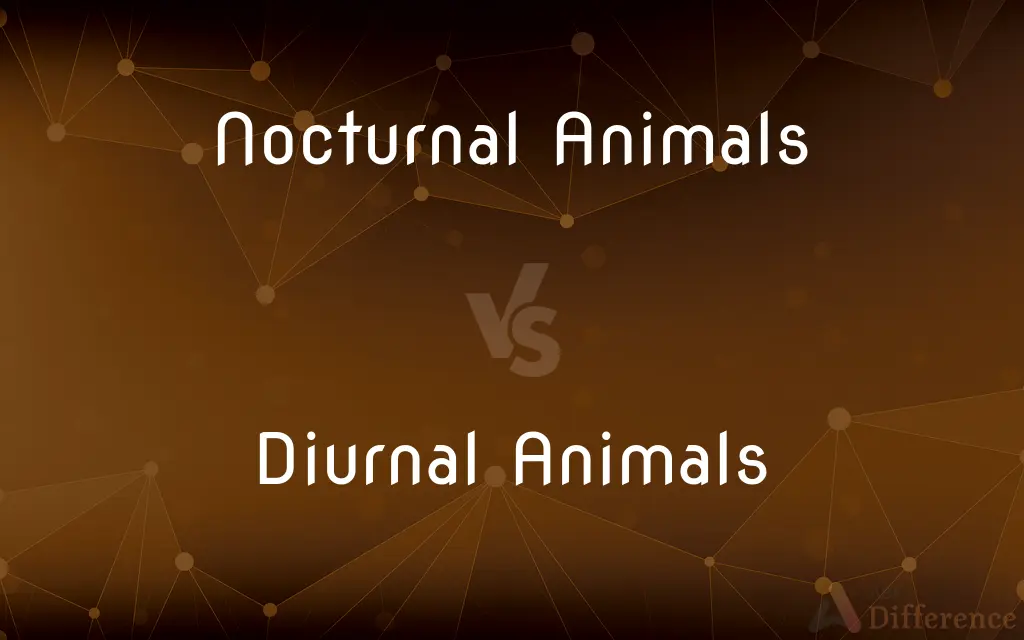Nocturnal Animals vs. Diurnal Animals — What's the Difference?
Edited by Tayyaba Rehman — By Fiza Rafique — Published on December 27, 2023
Nocturnal animals are active during the night; diurnal animals are active during the day.

Difference Between Nocturnal Animals and Diurnal Animals
Table of Contents
ADVERTISEMENT
Key Differences
Nocturnal animals are creatures that have evolved to be most active during nighttime hours. These animals have specific adaptations, like enhanced night vision, which allows them to function effectively in low light conditions. On the other hand, diurnal animals have evolved to be most active during the daytime. They often have keen eyesight adapted for bright light and might take rest or sleep during the night.
Nocturnal animals, by being active during the night, often avoid predators and extreme environmental conditions that may be present during the day. Diurnal animals, conversely, may leverage the sunlight for warmth or to aid in hunting and foraging. The division between these two types of animals is largely based on their behavior and the time they choose to carry out their daily activities.
In some ecosystems, nocturnal animals play a crucial role in maintaining balance, especially in the food chain. They may feed on certain pests or plants, controlling their numbers. Diurnal animals also play a significant role in their habitats, often pollinating flowers or controlling insect populations. The presence of both nocturnal and diurnal animals ensures that resources are utilized around the clock.
While nocturnal animals are primarily known for their night-time activities, there are some exceptions, and they might occasionally be active during the day. Similarly, diurnal animals might sometimes be seen during the night, although it's less common. Both groups have evolved in ways that benefit their survival and reproduction.
Lastly, nocturnal animals tend to have physical adaptations like larger eyes for better light absorption and whiskers for sensing their environment in the dark. Diurnal animals might have adaptations like a sharp vision in bright light or colors that camouflage them well during daylight.
ADVERTISEMENT
Comparison Chart
Active Time
Night
Day
Vision Adaptations
Enhanced night vision
Adapted for bright light
Predation/Foraging
Avoid daytime predators
Utilize sunlight for tasks
Common Adaptations
Larger eyes, whiskers
Sharp vision, bright colors
Activity Exceptions
Occasionally active during the day
Less commonly active during the night
Compare with Definitions
Nocturnal Animals
Nocturnal animals might have evolved night habits to exploit specific food sources.
Certain nocturnal animals feed on insects that come out only at night.
Diurnal Animals
Diurnal animals often have keen eyesight adapted for bright conditions.
Hawks, as diurnal animals, spot their prey from great heights in broad daylight.
Nocturnal Animals
Nocturnal animals are creatures that operate mainly at night.
Owls are classic examples of nocturnal animals.
Diurnal Animals
Diurnal animals often utilize sunlight for various activities, from hunting to warming up.
Chameleons, being diurnal animals, bask in the sun to regulate their body temperature.
Nocturnal Animals
Nocturnal animals often evade daytime predators by being active at night.
Bats, being nocturnal animals, fly out only after sunset.
Diurnal Animals
Diurnal animals are creatures that are primarily active during daylight hours.
Eagles, being diurnal animals, hunt during the day.
Nocturnal Animals
Nocturnal animals have specialized adaptations for low-light conditions.
The eyes of a cat, a nocturnal animal, glow in the dark.
Diurnal Animals
Diurnal animals might rest or sleep during the night, conserving energy for daytime.
Lions, though diurnal animals, can sometimes be seen resting under a tree in midday.
Nocturnal Animals
Nocturnal animals can be found in various habitats, from deserts to forests.
Raccoons, nocturnal animals, are often spotted rummaging through trash at night.
Diurnal Animals
Diurnal animals can be found in diverse ecosystems, from grasslands to oceans.
Dolphins, diurnal animals, often leap out of water during the day.
Common Curiosities
Are all cats considered nocturnal animals?
While many cats have nocturnal tendencies, domesticated cats can adapt to their owner's schedule.
Do nocturnal animals see in complete darkness?
Nocturnal animals have enhanced vision for low light, but they don't see in complete darkness.
Are all birds diurnal animals?
While many birds are diurnal, some, like owls, are nocturnal.
Do nocturnal animals have better hearing than diurnal animals?
While some nocturnal animals have evolved enhanced hearing, it's not universally true for all.
What time are nocturnal animals most active?
Nocturnal animals are most active during the night.
What are some common adaptations of nocturnal animals?
Nocturnal animals might have larger eyes, whiskers, and enhanced senses to navigate the night.
What's the primary reason some animals are diurnal?
Diurnal animals have evolved to be active during the day to utilize sunlight and might have fewer nighttime predators.
Do nocturnal animals sleep during the day?
Yes, many nocturnal animals rest or sleep during the day.
Why don't diurnal animals simply adapt to be nocturnal in predator-rich areas?
Evolutionary changes are complex. Some diurnal animals might have specific roles or advantages in their ecosystems during the day.
How do diurnal animals protect themselves from predators?
Diurnal animals might use camouflage, speed, group behaviors, or other defensive tactics during the day.
How do diurnal animals rest?
Diurnal animals typically rest or sleep during the night, conserving energy for daytime activities.
How do diurnal animals cope with extreme heat in some habitats?
Some diurnal animals become crepuscular (active during dawn and dusk) to avoid extreme midday heat.
Can a diurnal animal become nocturnal and vice versa?
While some animals might shift their activity patterns due to various factors, their inherent tendencies are hardwired.
Are there more nocturnal or diurnal animals?
Both types are widespread, and the prevalence might vary based on the specific habitat or ecosystem.
Why are some desert animals diurnal, given the heat?
Some desert diurnal animals have evolved to tolerate heat, while others might be crepuscular to avoid the hottest times.
Share Your Discovery

Previous Comparison
Coral vs. Peach
Next Comparison
Cilia vs. MicrovilliAuthor Spotlight
Written by
Fiza RafiqueFiza Rafique is a skilled content writer at AskDifference.com, where she meticulously refines and enhances written pieces. Drawing from her vast editorial expertise, Fiza ensures clarity, accuracy, and precision in every article. Passionate about language, she continually seeks to elevate the quality of content for readers worldwide.
Edited by
Tayyaba RehmanTayyaba Rehman is a distinguished writer, currently serving as a primary contributor to askdifference.com. As a researcher in semantics and etymology, Tayyaba's passion for the complexity of languages and their distinctions has found a perfect home on the platform. Tayyaba delves into the intricacies of language, distinguishing between commonly confused words and phrases, thereby providing clarity for readers worldwide.













































